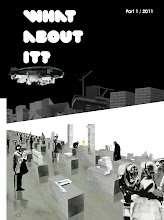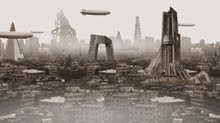
Megastructures are the Shopping Malls of the Avant-Garde
Avant-Garde
The avant-garde is a paradoxical state. In order to exist, it relies on its incongruous condition of being both fundamentally contemporary and ahead of its time. A conceptual palimpsest, the avant-garde requires writing its history over its own past keeping a vulnerable balance between present problems, and possible future solutions. All about contextualizing the perfect timing, what happens when the avant-garde goes out of sync; when its solutions are overlooked for being too premature, or ridiculed for being delayed?
In the past century alone, the avant-garde was victim of two untimely appearances. In the first one, its proposals arrived too early; the world was taken aback by the boldness of its ambitions, by the audacity of its delirium. In the second coming, the avant-garde was too late. Here its stratagems were on a futile mission of inventing a program that already existed.
These consecutive setbacks have concealed the potential of a parallel form of urban intelligence that not only is able to complete even the most ambitious truncated plans of the avant-garde in Europe, but that can also propose and achieve a set of alternative and original forms of urbanism. Can a genealogy of key events in the 20th century reveal the potential of this parallel non-European universe, and its relationship to the avant-garde as we know it?
Le Corbusier 1922
In 1922 Le Corbusier presented the first of his “ideal” cities. La ville contemporaine pour trois millions d’habitants was an urban layout of cruciform skyscrapers, housing slabs and a carpet of parks intersected by juxtaposed grids of car infrastructure. In this urban plan Le Corbusier was not only aspiring for a greener, denser, centralized, bureaucratic, car oriented city, but the plan suggested the ideal conditions for Modern Architecture to flourish.
The Ville Contemporaine was like an abstract diagram. When the modernist plans started to take shape on real cities, first in Paris with the Plan Voisin (1925), then in the rest of the world with the Ville Radieuse (1935), the image of Le Corbusier oscillated between a visionary and a madman. His preoccupations were clearly fundamental problems of his time, but the formalization of his ideas were not always welcomed. Even if the cities of his time had needed more hygienic and organized schemes, buildings that were more suitable to live in, collective housing that distanced itself from the Haussmanian family flat and an overall vision that complied better with the new technological advancements, the people were not ready for Le Corbusier.
Alongside with the criticsm generated by his ideal cities, the core urban values of travailler, habiter, circuler et cultiver le corps et l'esprit, adopted by the CIAM and integrated in the Athens Charter (1933), turned out to be the focus of attacks after the Second World War broke out in Europe and left the urban and social situation in a much worse and urgent condition than the one that Le Corbusier had rebelled against in the 1920’s.
Bifurcation
After evidencing the destructive side of modernization (of warfare), the social and economic conditions at the end of the war put under harsh scrutiny the urban plans which aimed to bulldoze the old city centers away. The love for the old city was politically reinforced by the collective memory. With this situation in the background, a young generation of architects willing to continue to explore the possibilities of the modern plan (Team 10 being one of them) wished therefore to distance themselves from the highly criticized urban visions of Le Corbusier.
The war with its obliterating outcome not only represented the destruction of the old-European world, but marked the meltdown of the urban visions of Le Corbusier. After the war a halt was put to the avant-garde and its city, at least on European soil.
However, the year 1956 saw three distant although simultaneous events that marked the fate of the avant-garde for the remainder of the 20th century, not only giving new life to the plans of Le Corbusier, but creating new forms of urbanism. Unfairly overlooked, these events characterize key moments in the development of an international program for “the” city.
Brasilia 1956
In 1956 Brasilia started construction. The Brazilian president Juscelino Kubitschek orchestrated the creation of the new capital with the construction of the first government building by Oscar Niemeyer, and with the “Plano Piloto de Brasília” competition which was won by Lucio Costa a year later.
Anchored on a virgin site, Brasilia was the apotheosis of the modernist city; a tabula rasa without the bulldozer. Was Kubitschek the client Le Corbusier always wanted?
At first sight Brasilia makes its aesthetics recognizable to the modernist lens. But, even if in the the Brazilian capital the spotlight tends to shift to the features of Niemeyer’s concrete monoliths and radically thin slabs, a closer inspection reveals an even deeper connection with the Le Corbusian city. The layout with its centralized government, its concrete housing slabs, its grid of streets and avenues, and with the years, the park within the city –all the vegetation and trees— not only appear so strikingly similar but reinforce the belief in the city of the four values. Modern Architecture in a Modern City. Brasilia was, after so many defeats, a victory for the modernist front.
Was Lucio Costa Le Corbusier’s Brazilian translator? Or was Le Corbusier’s avant-garde dream unintentionally designed for Brazil? Was his image of the city of today meant to find consecration someplace other than Europe? Was he imagining his cities somewhere where the collective memory wasn’t as infatuated by the past? Was his architecture giving him away all this time—the pilotis, the garden roof, the horizontal window, all so suspiciously tropical?
New Babylon 1956
In 1956 Constant was gestating the ideas of Brasilia’s antithesis: New Babylon. While the first urban avant-garde was evaporated from the post-War Europe and re-launched as poured concrete and asphalt in Brazil, it was in the old continent again where a “new” avant-garde was to set its second attack on the contemporary city.
Constant’s model for urbanization was comprised of an ever-expanding, ever-mutating series of sectors that were to hover above the old European city like a weightless cloud. New Babylon was one of the first Megastructures: colossal complexes that could mix programs and be developed ad infinitum. Architectural plankton accumulating in the urban ocean.
Using automation as the tour de force of the new city, New Babylon proposed to abolish the city from the core values of a Le Corbusier driven urbanism. If Brasilia was centralized, bureaucratic and predictably pre-programmed, New Babylon didn’t have a center, possessed no cars, and its people needed no recreation since there was no need to work. New Babylon was the apotheosis of the laissez-faire lifestyle, an Eden for drifters.
In New Babylon even environmental conditions like daylight were evaporated, giving the homo ludens that inhabited it total freedom to drift à la dérive. The first proposal of a perversely naïve post-war avant-garde, New Babylon was betting on the originality of a plot that like a form-less black hole was to absorb everything into designed disorder.
Southdale Center, 1956
Meanwhile in 1956 Victor Gruen’s Southdale Center, the first air conditioned, enclosed shopping mall, opened to the public in a Minneapolis suburb. Southdale Center was the first of a series of buildings that—like the Megastructures—were to create an artificial environment that would free the users from the complications of the city. A shelter from crime, dirt, and any kind of environmental problem, the shopping mall represented the ultimate achievement of commercial architecture; the apotheosis of consumer culture.
The Shopping mall offered a new type of facsimile reality enclosed in a cluster of walls and juxtaposed corridors. Soon these programs would mutate –like the promise of the Megastructures—to include all kinds of uses, from theme parks, to museums, to housing, working and recreation, in a kind of forced marriage between Le Corbusiean urbanism, and New Babylonian dreaminess.
Was Victor Gruen the architect New Babylon needed? Or was New Babylon the Shopping Mall of the avant-garde? How can the ultimate capitalist enterprise coincide with the ultimate Marxist project? Was the post-war avant-garde dreaming about what the most commercial of enterprises was already achieving? Or was the commercial architect revealing a parallel form of urban avant-garde far from the utopian orthodoxies of Europe?

Après-Garde
This series of urban aspirations and confrontations—the Le Corbusiean city as the Modernist city, Brasilia as a Le Corbusiean city, New Babylon as the anti-Brasilia, Southdale Center as the anti-New Babylon—reveal at least two outcomes that are opposed to the general perception of the role, potential, and limitations of the urban European avant-garde, and highlights the existence of other simultaneous forms of non-European urban intelligentsia.
At first hand, while it can be argued that Le Corbusier didn’t accomplish on European soil the plans envisioned in his first three urban models, the fact that it was in Brasilia that the unavoidable triad—client, urbanist, architect—was finally summoned to concretize the modernist master plan, highlights if not a relay of the avant-garde in South America, a parallel version of it, and exposes the vindication of what at first seemed to be just a frustrated attempt by Le Corbusier to frame the contemporary city with his modernist values.
On the other hand, the struggle of New Babylon to break away from the values of the Le Corbusiean city displayed not just the incapability of the post-war avant-garde to draw a new urban program, but the failure to precede its commercial counterpart in America when trying to “invent” a new form of Megastructure or contained city. This reinforces the idea that a new form of urban intelligentsia that differs from the pre-established canon of the European avant-garde was not only a possibility, but already a fully fledged reality, creating what could be the first urban Après-Garde: a group of architects that not only managed to complete the unfulfilled dreams of the avant-garde, but that were able to “invent” the forms of urbanism that were not yet “created” by the avant-garde.
In this sense, these two “discoveries”, the afterlife of the modernist city, and the birth of the Après-Garde, not only highlight the vital possibilities of the avant-garde in a post-Pruitt-Igoe world full of post-modernist non-sense, it emphasizes other forms of urban innovation. And even if it might well be true that these new forms of urban intelligentsia have existed parallel to the avant-garde, the avant-garde’s inherent potential, even with misconceived or untimely proposals is that it is and will always be just a beginning.

















































